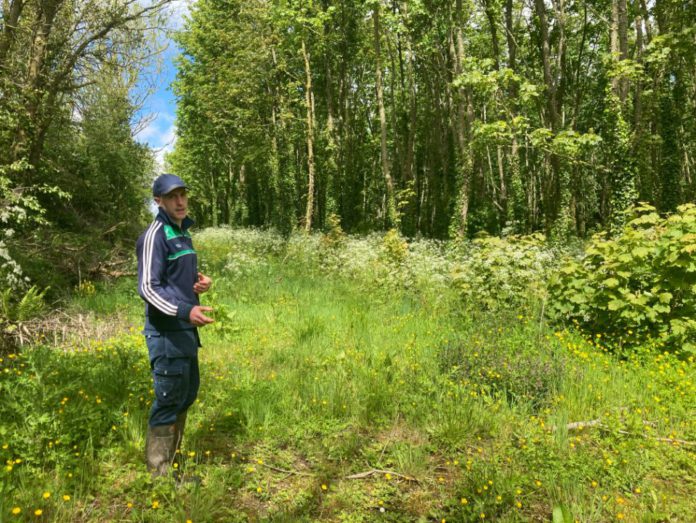Limerick dairy farmer, Gearoid Maher, has joined the growing Farming for Nature ambassador network.
Maher farms 80 hectares in Cappamore Co. Limerick, where he has a herd of pedigree Friesians and rears all subsequent progeny.
Animals graze from mid-March to the end of October, with an overall stocking rate of 1.5 livestock units/ha. The grazing season ranges from 220-240 days.
The biodiversity enthusiast has planted trees all around the farm, has an orchard, hedges, and tree lines throughout the fields.
Besides, he has 20-acres of forestry. He aims to thin the forest and allow cattle to dig up and graze the ground vegetable to help regenerate the forestry floor.
He cuts hay and silage from the land and feeds to cattle during the winter months. Gearoid feeds locally grown sugar beet to cows over winter. This has halved the amount of concentrates fed on the dairy farm.
Reducing fertiliser use by 25%
The land is a heavy clay-type and requires careful management. Gearoid carries out regular soil tests to determine what specific nutrients are required in each field and at what exact quantity.”
He has “substantially” reduced chemical nitrogen application by introducing clover into the sward and precision farming.
“I reduced my nitrogen use by approximately 25% on the farm last year as I now have the proper equipment.”
Maher has been gradually increasing the clover content in the grassland and has sown some multispecies grass swards on the farm.
The Farming for Nature ambassador aims to improve soil biology and reduce the amount of fertiliser needed in the future.
He spreads all slurry produced on-farm by means of low emissions slurry spreading at a maximum rate of 2500gals/ac.
Since utilising this method, the Farming for Nature ambassador has noticed a “huge” increase in earthworm activity. Furthermore, he does not use any herbicides on the farm except for spot treatment of noxious weeds.
Gearoid does not believe in chasing targets on his farm. He enjoys a “slower pace of farming”, ensuring both his animals and nature thrive and letting the enterprise work for him.
“The old rule of thumb was a cow to the acre. That has been my ethos all along. If I can farm a cow to the acre without pressure, then that’s what I will do.”
“The biggest change I have seen is that I notice nature more, and I see it all around me every day,” he explained.
“When you are too busy, you don’t have time to notice. I do not feel as busy or as under as much pressure since I have started to take account of what is around me.”
Farming for Nature
Now in its fourth year, FFN aims to “source, share and celebrate” the stories of farmers across Ireland who manage their land in a way that sustains nature while providing a livelihood for their families.
This year’s FFN ambassadors come from across Ireland and includes beef, sheep, forestry, dairy, horticulture, and tillage farmers.
They manage a wide range of very “valuable” habitats, including species-rich grasslands and heaths, wetlands, woodlands, and hedgerows.
The FFN ambassador network comprises family farms, couples, and both male and female farmers.
“Being part of farming for nature means that I get to meet like-minded people and share ideas,” he said.
“The farming for nature circle will only get bigger, and it is great
to be a part of it,” he concluded.





